Last updated: October 22, 2024
The Mongols were nomadic people who conquered much of Asia and parts of Europe in the 13th under the leadership of Ghengis Khan. A large part of their success can be attributed to the horses they rode. But what kind of horses were these?
Genghis Khan’s army rode into battle on their native Mongolian horses. These horses were small, but they were strong and hardy. They also had a lot of endurance, which made them perfect for warfare. The Mongols may have also used other breeds of horses from the Eurasian Steppe, like Takhi and Kirghiz horses.
One of the fascinating aspects of Genghis Khan’s reign is the mounted army he commanded. What kind of horses did the Mongols ride during this time? And what role did these animals play in their conquests? In this article, we’ll explore the history and significance of Mongolian horses during Ghengis Khan’s reign.
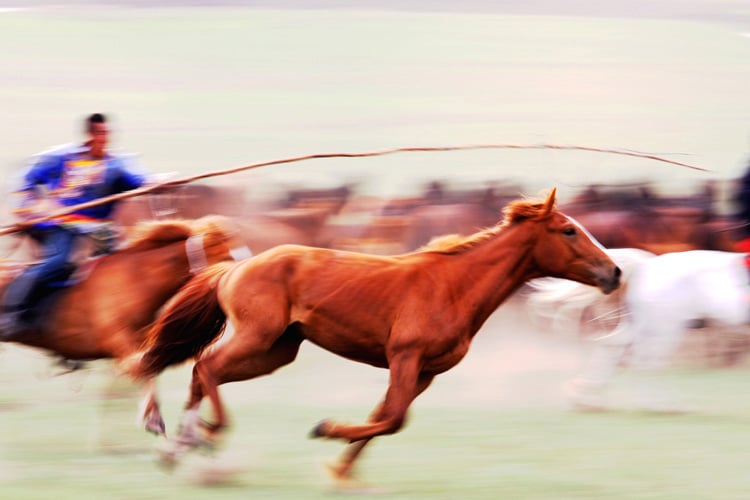
What is the Mongol Empire, and what did it encompass during Ghenghis Khan’s reign?
Born around 1162, Genghis Khan was a Mongolian ruler who created the largest contiguous empire in history. By the time of his death in 1227, the Mongol Empire stretched from China to Europe, encompassing a territory between 9 and 12 million square miles.
How did this ambitious warlord unite such a disparate group of people? One key factor was his skill as a tactician. He was famously unpredictable on the battlefield, and his opponents never knew what to expect.
This helped him win many crucial victories, which convinced more and more people to join his cause. In addition, Genghis Khan was an expert horseman, and he used this skill to great effect in battle.
His Mongolian warriors were some of the most fearsome fighters of their time, and they struck fear into the hearts of their enemies. Finally, Genghis Khan was a gifted diplomat, and he used this talent to forge alliances with other tribes.
By enlisting their support, he was able to build a vast army that was impossible to defeat. Genghis Khan united many disparate tribes into a single political and military force thanks to his military prowess, political acumen, and diplomatic skills.
What type of horses did the Mongols ride into battle?
Mongol horses were small but incredibly hardy, able to withstand harsh conditions and travel long distances. The Mongol Empire was founded on the backs of these diminutive war horses, and they played a vital role in the Mongol conquests.
The Mongol cavalry was utterly feared by their enemies and with good reason. Their horses were agile and fast in battle, allowing their riders to execute complex maneuvers quickly. Warriors often rode for hours or even days, covering vast distances across the steppe.
The Mongolian horse was crucial to the army’s success and helped establish Genghis Khan, one of history’s most notorious conquerors.
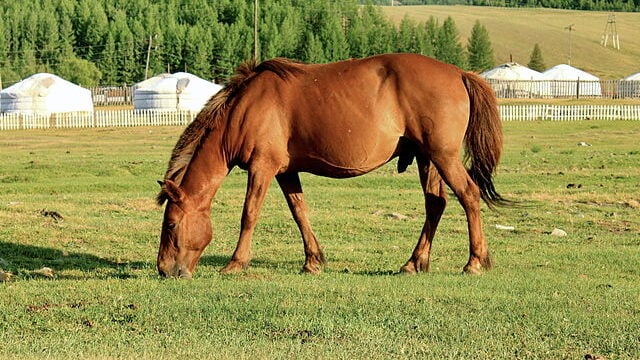
Mongol warriors took care of their horses.
Under the leadership of Genghis Khan, the Mongol troops were known for their ferocity and skill in battle, but they were also renowned for their knowledge, care, and treatment of their horses.
Genghis Khan believed that a strong horse was essential to Mongolian success on the battlefield, and he insisted that his troops take good care of their animals. Mongolian soldiers often went to great lengths to ensure their horses were well-fed and protected in battle.
It was typically for a Mongolian warrior to have three or four horses so that each was given a break from carrying its rider during long journeys. And before combat, riders covered the heads of their battle steeds with leather and its body with armor.
An excellent example of Ghenghis Khan’s knowledge of horses occurred during the battle of the Kalka River. After initially engaging the Georgian calvary, the Mongols appeared to retreat and lured the much larger detachment on a chase.
When their horses were exhausted, the Mongols switched to fresh horses and charged their opponent. The Georgian army was disastrously defeated.
In many ways, the Mongolians’ relationship with their horses mirrored the close bond between a rider and his mount. The Mongolians’ solicitous treatment of their horses was one of the many factors that contributed to their military success.
Mongolian spiritual beliefs regarding their horses.
Mongolians have a strong spiritual connection to horses. For Mongolians, the horse is not just a means of transportation or an animal used for labor. Instead, Mongolians see the horse as a sacred being with a unique spirit.
They believe that the horse is a gift from the gods and that its mane contains the horse’s spirit and strength. Mongolians also use the horse’s milk in purification ceremonies. Often warriors killed in battle were buried with their horses so they could spend the afterlife together.
Horses provided sustenance to warriors.
Mongolian horses are some of the hardiest in the world. They can withstand harsh conditions and survive on little food or water. This ability was put to the test by Mongol warriors, who would often travel for long periods without access to fresh supplies.
During long campaigns, Mongol warriors would often drink the blood of their horses to stay hydrated, and the milk provided them with essential nutrients. Marco Polo wrote about this unusual diet in his travels and noted that the Mongolians were some of the most fearsome warriors he had ever seen.
The Mongols were also expert horsemen, and they used their horses to great effect in battle. In addition to being used in warfare, horses were also crucial for transportation and hunting. Mongol horses were well-adapted to the harsh conditions of the steppe, and they played a vital role in everyday life of the Mongol people.
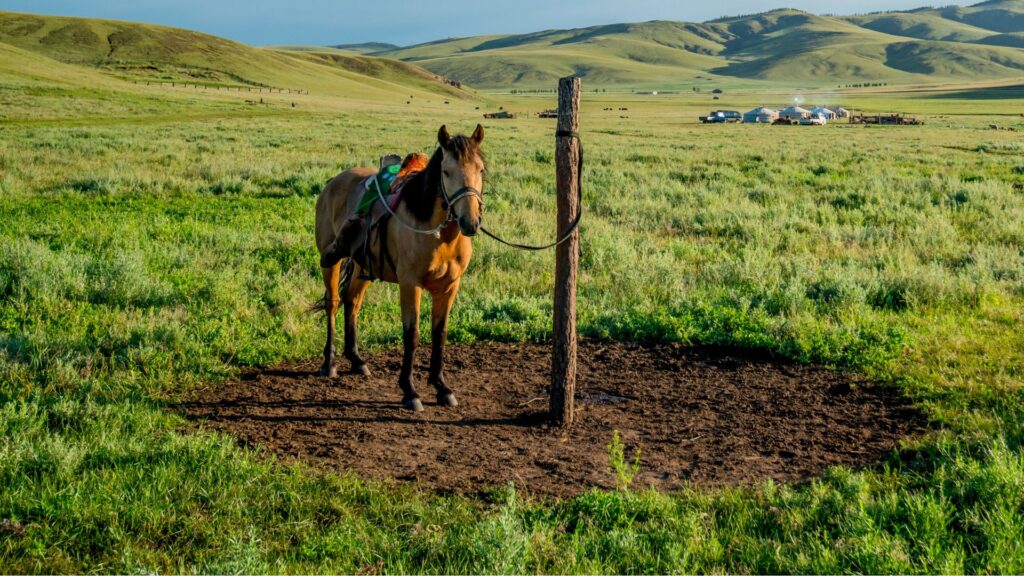
Mongolian Horse: Facts, Characteristics, and Uses
Mongolian horses are indigenous to the Mongolian steppe. They are considered one of the oldest breeds of horses in the world and have been used by the Mongols for centuries for riding and as pack animals.
Despite their name, Mongolian horses are not only found in Mongolia. They can also be found in other parts of Asia, such as China and Russia. They are a versatile breed used for many purposes, including riding, farming, and hauling.
One interesting fact about Mongolian horses is that they can tolerate extreme weather conditions, thrive in hot and cold climates, and even survive in areas with little or no water.
Another thing that makes Mongolian horses unique is their temperament. They are known for being calm and gentle animals, which makes them suitable for riding. They are also very sure-footed, which makes them ideal for traversing rugged terrain.
Mongolian horses are currently not considered an endangered species and outnumber humans in Mongolia. They remain an essential part of the culture and economy of Mongolia and other parts of Asia.
Characteristics of the Mongolian Horse
Mongolian horses usually have a light-colored, sandy brown, or tan coat and weigh anywhere from 500 to 600 pounds. They stand around 12 to 14 hands high and have a thick, wooly coat that helps keep them warm in cold climates.
Mongol horses are valued for their long manes and tails, which are often used for making ropes and violin bows. They are also hardy animals and can survive in harsh conditions.
Mongolian horses originated in the steppes of Mongolia, where the climate is cold and dry. They have strong bones and hooves and can withstand long travel periods.
Mongolian nomads have been using these horses for centuries, and they are still used today for transportation, herding, and racing. Mongolian Horses are also used in traditional Mongolian folk dancing.
Mongol horses are not only known for their physical strength but also their intelligence. They are considered to be one of the smartest horse breeds. They are quick learners and can remember commands easily. Mongolian Horses are also very social animals and enjoy being around people.
However, they can also be stubborn at times. But with proper training, they can be excellent riding and working partners.
What are Mongol Horses Used For?
Mongolian horses are used today for various purposes. Some people use them for racing, others for horseback riding or as working animals on farms, and some for meat and milk. They are also used in ceremonies and as part of traditional Mongolian dress.
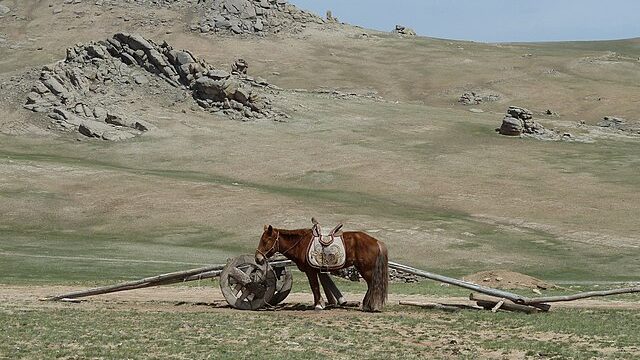
Do people still ride Mongolian horses?
Mongolian horses are a wonderful breed, and yes, people are still riding them. For centuries, Mongolians have relied on these horses to help them travel across the vast Mongolian steppe.
Today, Mongol horses are still used for transportation, but they are also among tourists who want to experience life on the Mongolian steppe. In addition, Mongol horses are increasingly being exported to other countries, where they are coveted for their unique abilities.
Mongolian horses are strong, resilient, and sure-footed, and they’ll give you an experience of a lifetime. Just be prepared for a bit of a challenge, as they can sometimes be a handful.
Are Mongolian Horses good for beginner riders?
Mongolian horses are intelligent animals known to bond with their riders. They are also known for being sure-footed, making them ideal for beginners still getting used to riding.
However, it’s important to remember that they can be high-strung, so it’s essential to approach them cautiously. A Mongolian horse may be a perfect choice if you’re looking for a beginner horse that is calm and gentle but also has some spunk.
However, if you’re lucky enough to find a Mongolian horse trained for trail riding, you’ll be in for an incredible experience. These horses are tough and resilient and will surely give you a ride of a lifetime. Just be prepared for a bit of a challenge, as they can sometimes be a handful.
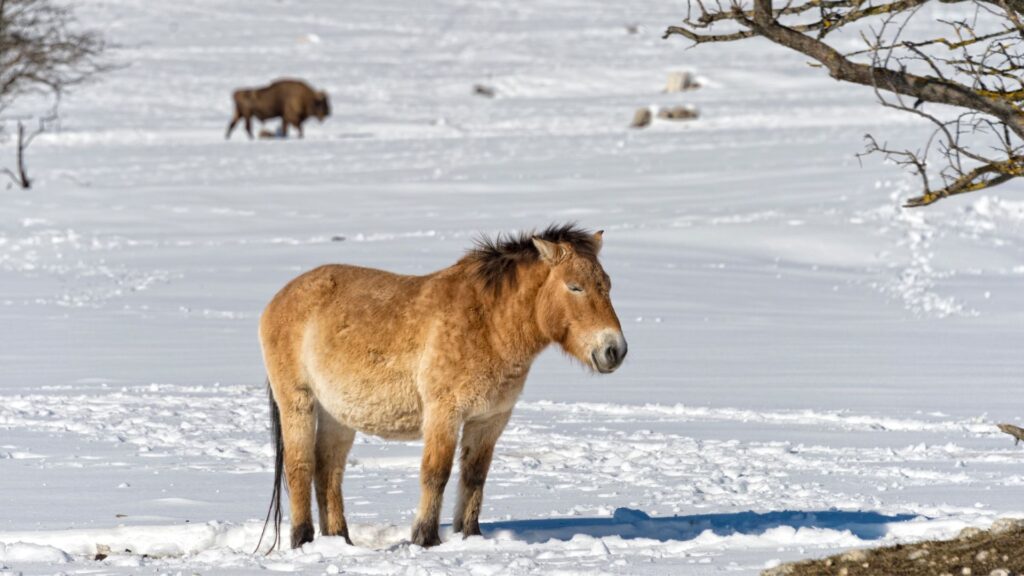
Are Mongolian Horses endangered?
Mongolian horses are a unique breed, and they’re becoming increasingly popular worldwide. They are not endangered; in fact, there are more than 3 million horses in Mongolia alone.
People often confuse Mongolian horses with the rare Przewalski’s horse. Both are from the same region but are otherwise different animals.
Takhi (the Przewalski horse)
Przewalski’s horse is the last remaining species of wild horse; in Mongolia, they are called Takhi horses. These horses were once widespread throughout Central Asia, but they nearly went extinct in the wild in the not-so-distant past.
Przewalski’s horses are smaller than Mongol horses and have different coat patterns. They are also the only species of horse that has never been tamed. However, it’s believed Mongolian herders and warriors used to ride them, but this is not confirmed.
Przewalski’s horses live in steppe grasslands and eat grasses and other plants in the wild. They live in herds headed by a stallion, and each herd contains several mares and their foals.
Mongolian farmers sometimes capture young stallions and sell them to zoos or private owners, but most of Przewalski’s horses live in reserves in Mongolia, Kazakhstan, China, and Russia. Today there are roughly 2,000 Takhi horses in the world.
Below is a YouTube video of Mongolian horsemen breaking a wild horse
FAQs
Why are Mongolian horses so small
Mongolian horses are small because their size thrives in Mongolia’s harsh climate. It’s confirmation of natural selection, wherein individuals with adaptive traits are more likely to survive and reproduce.
Are Mongolian horses gaited?
Yes, some Mongol horses execute the ambling gait, which allows them to cover the ground more efficiently. However, gaited horses are the exception in the Mongol breed.

About the Author: Miles Henry
Lifelong Horseman | Racehorse Owner | Published Author
Miles Henry brings over 25 years of hands-on experience training and owning Thoroughbred racehorses. Raised with Quarter Horses and Appaloosas, he’s spent a lifetime learning from horses—on the track, in the barn, and in the field. Today, he runs a small but successful racing stable in Louisiana and shares real-world insights on HorseRacingSense.com, helping horse owners, fans, and bettors navigate the sport with confidence.
📚 Books: View Miles’s books on Amazon »
🎧 Podcast Guest: Animal Tales Ep. 32 |
YouTube Interview
📩 Newsletter: Sign up for racing tips and horse care advice »
🔗 Follow Miles:
Twitter |
Facebook |
YouTube


